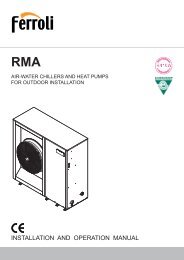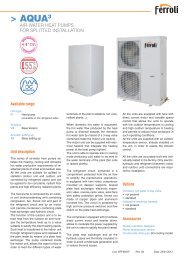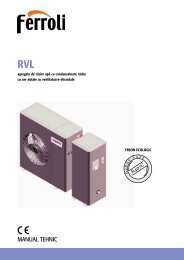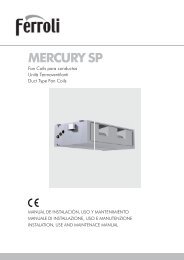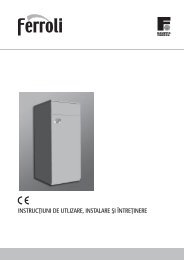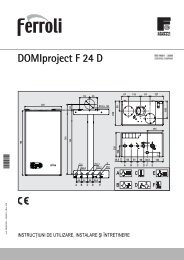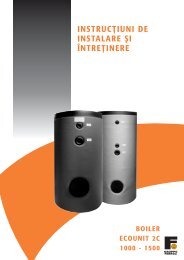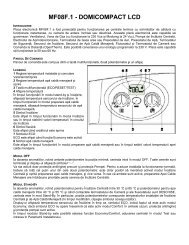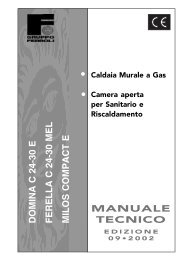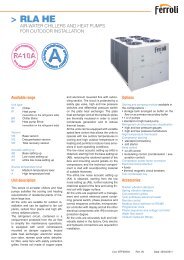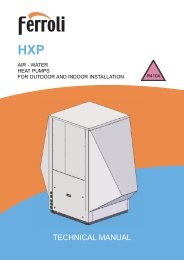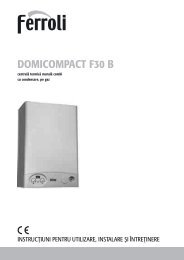HMP - Ferroli
HMP - Ferroli
HMP - Ferroli
- No tags were found...
You also want an ePaper? Increase the reach of your titles
YUMPU automatically turns print PDFs into web optimized ePapers that Google loves.
GENERAL FEATURESGeneral instructionsThis manual and the wiring diagram supplied with the unit must be kept in a dry place for possible future consultation.The manual provides information on installation and correct use and maintenance of the unit. Before carrying out installation,please carefully read all the information contained in this manual, which describes the procedures necessary for correctinstallation and use of the unit.Follow carefully the instructions contained in this manual and respect the safety regulations in force. The unit must be installedin conformity with the laws in force in the country of use. Unauthorized tampering with the electrical and mechanical equipmentINVALIDATES THE WARRANTY.Check the electrical specifications given on the dataplate before making the electrical connections. Read the instructions given in thespecific section on electrical connections.Deactivate the equipment in case of fault or poor operation.If the unit requires fixing, contact only specialized service centers recognized by the manufacturer and use original spare parts.The unit must be installed outdoor or indoor and connected to a hydronic cooling and/or heating system. Any use different from thatpermitted or outside the operating limits indicated in this manual is prohibited (unless previously agreed with the firm).The manufacturer declines any responsability for damage or injury due to non-compliance with the information given in this manual.Declaration of conformityThe firm declares that the present unit complies with the requirements of the following directives :• Machinery directive (MD) 2006/42/EC• Pressure equipment directive (PED) 97/23/EC• Electromagnetic compatibility directive (EMC) 2004/108/EC• Low voltage directive (LVD) 2006/95/ECUnit dataplateThe figure shows the fields reported on the unit dataplate :CodiceCodeB1 RevA - TrademarkB - ModelB1 - CodeC - Serial numberD - Capacity in cooling at the condition A35W18E - Capacity in heating (heat pump) at the condition A7W35F - Power input in cooling at the condition A35W18G - Power input in heating (heat pump) at the condition A7W35H - Reference standardI - Power supplyL - Maximum absorbed currentM - Refrigerant type and charge weightN - Unit weightO - Sound pressure level at 1 metreP - IP protection levelQ - Maximum pressure - high pressure sideR - Maximum pressure - low pressure sideS - PED certification body<strong>Ferroli</strong> SpaVia Ritonda 78/A(VR) Italy4
GENERAL FEATURESUnit descriptionThis series of air-water heat pumps satisfies the heating, coolingand domestic hot water production requirements of residentialplants of small and medium size.All the units are suitable both for outdoor or indoor installationand can be applied to fan coil plants, radiant floor plants andhigh efficiency radiators plants.The control system allows to manage not only the refrigerantcircuit but the whole plant with the possibility to choose differentsolutions both for the heating and cooling plant and for the domestichot water management. The possibility of solar panels orother heating sources integration is also available.The heating function optimizes the flow water temperature accordingboth to the ambient temperature and to the outdoor temperaturethrough climatic curves adaptable to the building features.It’s possible to manage a storage tank and two independentcircuits (a direct one and a mixed one).The domestic hot water management allows to control the threeway valve, the storage tank and the anti-legionella cycles (ifnecessary).The cooling function can be realized through “active cooling”(refrigerant circuit inversion). When the unit is used in radiantfloor plants, to avoid condensate generation, a room humiditysensor can be installed.The internal programmer clock allows to define different dailyswitching programs for heating, cooling and domestic hot waterproduction.The refrigerant circuit, contained in a box repaired from the airflow to simplify the maintenance operations, is equipped withscroll compressor mounted on damper supports, brazed plateheat exchangers, electronic expansion valve, reverse cycle valve,centrifugal fan (plug fan), finned coil realized with copperpipes and alluminium fins. The circuit is protected by high andlow pressure switches and flow switches on the plate heat exchanger.The plate heat exchanger and all the hydraulic pipes are thermallyinsulated in order to avoid condensate generation and reducethermal losses.The plug fan with electronic control of the rotational speed guaranteeshigh efficiencies and low noise in all the operating conditionsand allows to install the unit both outdoor (with protectioncaps) or indoor (with ducted air inlet and outlet).All three-phase power supply units are provided with a phasesequence and correct sequence controller device.All the units are supplied with an outdoor temperature sensor inorder to realize the climatic control.All the units are accurately built and individually tested in thefactory. Only electric and hydraulic connections are required forinstallation.Unit identification codeThe codes that identify the units and the meaning of the letters used are described below.<strong>HMP</strong>IP 35.1 VB AB 0 M 5Unit typeIP - Units suitable for hydronic plant installationoperating as reversible heatpumpsPower supply1 - 230V - 1 - 50 Hz5 - 400V - 3N - 50 HzOperating rangeM - Medium temperature.The unit is suitable to producewater at medium temperature.Unit modelRefrigerant typeN° compressors0 - R410AUnit versionVB - Base versionAcoustic setting upAB - Base setting up5
GENERAL FEATURESOptionsPlant sideflow ratemanagementDomestic hot waterproductionStandard pumpHigh head pumpHigh efficiency pump3 way valveIntegrative electrical heatersSoft starterAllows the circulation of the water on the plant side.Allows the circulation of the water on the plant side and guarantees a higheravailable static head.Allows the circulation of the water on the plant side and guarantees a highefficiency.Allow to divert the hot water produced by the heat pump from the heating circuitto the domestic hot water circuit.Integrate or replace the heating power supplied by the heat pump and aremanaged by the unit controller with a 3 step logic.Reduces the compressor start current.Reversible heat pump (IP) without optionsThe controller flexibility and the big number of options availableallow to get, for each model, a lot of different configurations thatintegrate inside the heat pump many components of the plantand allow to realize compact and tested installations.In order to select the right configuration it is necessary to definethe type of plant to which the heat pump will be connected, bothfor what concerning the heating and cooling circuits, and for whatconcerning the domestic hot water management.Option “Plant side flow rate management”Pump (standard or high head or high efficiency)Option “Integrative electrical heaters”Option “Domestic hot water production”3 way valveIn this configuration the heat pump canbe coupled to a domestic hot watertank equipped with a coil designed fora maximum water temperature between55°C and 60°C.The anti legionella cycles have to beperformed by means of electrical heatersplaced on the heat pump outlet (seeoption “Integrative electrical heaters”) ordirectly inside the tank.8
TECHNICAL DATA AND PERFORMANCESTechnical dataFrame 1 2 3Model 24.1 27.1 31.1 35.1 40.1 45.1 U.M.Power supply 400 -3N- 50 400 -3N- 50 400 -3N- 50 400 -3N- 50 400 -3N- 50 400 -3N- 50 V-ph-HzRefrigerantType R410A -CompressorType scroll -Quantity 1 n°Power steps 0 - 100 %Oil charge 2,50 3,30 3,30 3,30 3,30 3,30 kgPlant side heat exchangerType stainless steel brazed plates -Quantity 1 n°Water volume 3,33 4,18 4,18 4,18 5,14 5,14 lSource side heat exchangerType finned coil -Quantity 1 n°Frontal surface 0,77 1,10 1,10 1,10 1,43 1,43 m 2FansType plug fan with high efficiency EC motor -Quantity 1 n°Diameter 630 630 630 630 630 630 mmMaximum rotational speed 680 680 680 680 1200 1200 rpmTotal installed power 0,54 0,54 0,54 0,54 2,80 2,80 kWPlant side hydraulic circuitExpansion vessel volume 10 lSafety valve set point 3 barPlant pump - standard (option)Type centrifugal pump -Quantity 1 n°Installed power 0,7 0,7 0,7 0,7 1,0 1,0 kWPlant pump - high head (option)Type centrifugal pump -Quantity 1 n°Installed power 1,2 1,2 1,2 1,2 1,6 1,6 kWPlant pump - high efficiency (option)Type inverter glandless pump -Quantity 1 n°Installed power 0,14 0,31 0,31 0,31 0,31 0,31 kWIntegrative electrical heaters (option)Total installed power 9,0 18,0 18,0 18,0 18,0 18,0 kWPower steps 0 - 33 - 66 - 100 %10
TECHNICAL DATA AND PERFORMANCESNOMINAL performances - Radiant plantsFrame 1 2 3Model 24.1 27.1 31.1 35.1 40.1 45.1 U.M.Power supply 400 -3N- 50 400 -3N- 50 400 -3N- 50 400 -3N- 50 400 -3N- 50 400 -3N- 50 V-ph-HzIPHeating A7W35 ( source : air in 7°C d.b. 6°C w.b. / plant : water in 30°C out 35°C )Heating capacity 23,5 26,9 30,7 34,3 39,6 45,2 kWPower input 5,18 5,81 6,79 7,75 8,72 10,0 kWCOP 4,54 4,63 4,52 4,43 4,54 4,52 -Water flow rate plant side 4052 4641 5299 5905 6823 7793 l/hPressure drops plant side 21 18 23 28 25 32 kPaHeating A2W35 ( source : air in 2°C d.b. 1°C w.b. / plant : water in 30°C out 35°C )Heating capacity 19,5 22,3 25,6 28,5 32,8 37,5 kWPower input 5,08 5,70 6,66 7,59 8,53 9,82 kWCOP 3,84 3,91 3,84 3,75 3,85 3,82 -Water flow rate plant side 3377 3862 4416 4918 5663 6477 l/hPressure drops plant side 15 13 16 20 18 23 kPaCooling A35W18 ( source : air in 35°C d.b. / plant : water in 23°C out 18°C )Cooling capacity 24,5 28,0 32,0 35,6 41,0 46,9 kWPower input 7,20 8,08 9,46 10,8 12,2 14,0 kWEER 3,40 3,47 3,38 3,30 3,36 3,35 -Water flow rate plant side 4242 4845 5535 6173 7104 8138 l/hPressure drops plant side 23 19 25 31 27 35 kPaData declared according to EN 14511. The values are referred to units without options or accessories.NOMINAL performances - Standard plantsFrame 1 2 3Model 24.1 27.1 31.1 35.1 40.1 45.1 U.M.Power supply 400 -3N- 50 400 -3N- 50 400 -3N- 50 400 -3N- 50 400 -3N- 50 400 -3N- 50 V-ph-HzIPHeating A7W45 ( source : air in 7°C d.b. 6°C w.b. / plant : water in 40°C out 45°C )Heating capacity 23,0 26,3 30,0 33,5 38,5 44,1 kWPower input 6,29 7,05 8,25 9,42 10,5 12,2 kWCOP 3,66 3,73 3,64 3,56 3,67 3,61 -Water flow rate plant side 3980 4553 5196 5805 6674 7629 l/hPressure drops plant side 21 17 22 27 24 31 kPaHeating A2W45 ( source : air in 2°C d.b. 1°C w.b. / plant : water in 40°C out 45°C )Heating capacity 18,9 21,7 24,9 27,7 31,9 36,4 kWPower input 6,19 6,95 8,12 9,25 10,4 11,9 kWCOP 3,05 3,12 3,07 2,99 3,07 3,06 -Water flow rate plant side 3285 3771 4310 4797 5527 6309 l/hPressure drops plant side 14 12 15 19 17 22 kPaCooling A35W7 ( source : air in 35°C d.b. / plant : water in 12°C out 7°C )Cooling capacity 19,1 21,8 24,8 27,6 31,8 36,4 kWPower input 6,65 7,47 8,73 9,95 11,2 12,8 kWEER 2,87 2,92 2,84 2,77 2,84 2,84 -Water flow rate plant side 3278 3741 4273 4754 5474 6264 l/hPressure drops plant side 14 12 15 19 17 22 kPaData declared according to EN 14511. The values are referred to units without options or accessories.11
TECHNICAL DATA AND PERFORMANCESHEATING performancesHeating capacityCBAThe graphs allow to get the corrective factors tobe applied to the nominal performances in orderto obtain the real performances in the selectedoperating conditions.The reference nominal condition is :A7W35source : air in 7°C d.b. 6°C w.b.plant : water in 30°C out 35°CDOutlet temperatureplant side :A = 55°CB = 45°CC = 35°CD = 25°CInlet air temperature w.b. [°C]Power inputCOPDCBAA B C DInlet air temperature w.b. [°C]Inlet air temperature w.b. [°C]12
TECHNICAL DATA AND PERFORMANCESCOOLING performancesCooling capacityThe graphs allow to get the corrective factors tobe applied to the nominal performances in orderto obtain the real performances in the selectedoperating conditions.The reference nominal condition is :A35W7source : air in 35°C d.b.plant : water in 12°C out 7°CA B C DOutlet temperatureplant side :A = 24°CB = 18°CC = 12°CD = 7°CInlet air temperature w.b. [°C]Power inputEERABCBDADCInlet air temperature d.b. [°C]Inlet air temperature d.b. [°C]13
TECHNICAL DATA AND PERFORMANCESPlant side hydraulic performancesPressure drops - unit without options605040.145.1Pressure drops [ kPa ]40302024.127.131.135.11000 1000 2000 3000 4000 5000 6000 7000 8000 9000Flow rate [ l/h ]Pressure drops to be added - unit with option “Integrative electrical heaters”605045.1Pressure drops [ kPa ]40302024.127.131.135.140.11000 1000 2000 3000 4000 5000 6000 7000 8000 9000Flow rate [ l/h ]The graphs are referred to units operating with water at the temperature of 10°C (density 1000 kg/m 3 ).14
TECHNICAL DATA AND PERFORMANCESAvailable static head - unit with option “Plant side flow rate management” : “Standard pump”24020040.145.1Available static head [ kPa ]1601208024.127.131.135.14000 1000 2000 3000 4000 5000 6000 7000 8000 9000Flow rate [ l/h ]Available static head - unit with option “Plant side flow rate management” : “High head pump”240200Available static head [ kPa ]160120804024.127.131.135.140.145.100 1000 2000 3000 4000 5000 6000 7000 8000 9000Flow rate [ l/h ]The graphs are referred to units operating with water at the temperature of 10°C (density 1000 kg/m 3 ).15
TECHNICAL DATA AND PERFORMANCESAvailable static head - unit with option “Plant side flow rate management” : “High efficiency pump”240200Available static head [ kPa ]1601208024.127.131.135.140.145.14000 1000 2000 3000 4000 5000 6000 7000 8000 9000Flow rate [ l/h ]The graphs are referred to units operating with water at the temperature of 10°C (density 1000 kg/m 3 ).Source side aeraulic performancesAvailable static head - unit without accessory “Protection cap” or “Lateral expulsion cap”908024.170Available static head [ Pa ]6050403027.131.135.140.1201045.100 2000 4000 6000 8000 10000 12000 14000 16000 18000 20000Flow rate [ m 3 /h ]In case of ducted installation the total pressure drops in the inlet and outlet ducts can not exceed the maximum available static head.The minimum duct section must guarantee that the medium air velocity does not exceed 2,5 m/s in order to avoid noise problems and to keep the pressuredrops as lower as possible.The graphs are referred to units operating with air at the temperature of 15°C (density 1,2 kg/m 3 ).16Frame 1 2 3Model 24.1 27.1 31.1 35.1 40.1 45.1 U.M.Maximum static headavailable for ducted installation50 50 50 50 150 150 U.M.
TECHNICAL DATA AND PERFORMANCESOperating limitsThe graphs reported below show the operating area inside which the correct working of the unit is guaranteed.HEATINGOutlet temperature - plant side [°C]Inlet air temperature d.b. [°C]COOLINGOutlet temperature - plant side [°C]Inlet air temperature d.b. [°C]Temperature difference between unit inlet and outletPlant sideDT max Maximum value 11 °CDT min Minimum value 3 °C17
TECHNICAL DATA AND PERFORMANCESElectrical dataUnitFrame 1 2 3Model 24.1 27.1 31.1 35.1 40.1 45.1 U.M.Power supply 400-3N-50 400-3N-50 400-3N-50 400-3N-50 400-3N-50 400-3N-50 V-ph-HzF.L.A. Maximum total current input 17,1 19,1 21,2 23,1 31,2 35,3 AF.L.I. Maximum total power input 10,8 12,1 13,4 14,6 19,4 22,0 kWMaximum total start current 116 132 139 146 165 199 AM.I.C. Maximum total start currentwith soft starter (option)57 66 70 74 87 107 AIntegrative electrical heaters (option)230-1-50 230-1-50 230-1-50 230-1-50 230-1-50 230-1-50Power supplyV-ph-Hz400-3N-50 400-3N-50 400-3N-50 400-3N-50 400-3N-50 400-3N-50Maximum total current input39,1 78,3 78,3 78,3 78,3 78,3 A( 230V - 1 - 50Hz )F.L.A.Maximum total current input13,0 26,0 26,0 26,0 26,0 26,0 A( 400V - 3N - 50Hz )F.L.I. Maximum total power input 9,0 18,0 18,0 18,0 18,0 18,0 kWPlant side pump - standard (option)Power supply 230-1-50 230-1-50 230-1-50 230-1-50 230-1-50 230-1-50 V-ph-HzF.L.A. Maximum total current input 3,6 3,6 3,6 3,6 5,1 5,1 AF.L.I. Maximum total power input 0,7 0,7 0,7 0,7 1,0 1,0 kWPlant side pump - high head (option)Power supply 230-1-50 230-1-50 230-1-50 230-1-50 230-1-50 230-1-50 V-ph-HzF.L.A. Maximum total current input 6,1 6,1 6,1 6,1 8,2 8,2 AF.L.I. Maximum total power input 1,2 1,2 1,2 1,2 1,6 1,6 kWPlant side pump - high efficiency (option)Power supply 230-1-50 230-1-50 230-1-50 230-1-50 230-1-50 230-1-50 V-ph-HzF.L.A. Maximum total current input 0,7 1,6 1,6 1,6 1,6 1,6 AF.L.I. Maximum total power input 0,14 0,31 0,31 0,31 0,31 0,31 kW18
TECHNICAL DATA AND PERFORMANCESWeightsFrame 1 2 3Model 24.1 27.1 31.1 35.1 40.1 45.1 U.M.Components weightsUnit without options 281 350 352 355 414 416 kgOptionsAccessoriesPlant sideflow ratemanagementStandard pump 5 9 9 9 11 11 kgHigh head pump 6 12 12 12 13 13 kgHigh efficiency pump 4 6 6 6 7 7 kgDomestic hot water production :3 way valve6 6 6 6 7 7 kgIntegrative electrical heaters 5 10 10 10 11 11 kgProtection cap 16 19 19 19 23 23 kgLateral expulsion cap 10 10 10 10 10 10 kgFrontal shutting panel 8 10 10 10 13 13 kgTransport weightsUnit without options 290 361 363 366 429 431 kgOptionsAccessoriesPlant sideflow ratemanagementStandard pump 5 9 9 9 11 11 kgHigh head pump 6 12 12 12 13 13 kgHigh efficiency pump 4 6 6 6 7 7 kgDomestic hot water production :3 way valve6 6 6 6 7 7 kgIntegrative electrical heaters 5 10 10 10 11 11 kgProtection cap 25 30 30 30 38 38 kgProtection caps (quantity 2) 41 49 49 49 61 61 kgLateral expulsion cap 19 21 21 21 25 25 kgFrontal shutting panel 9 11 11 11 14 14 kgOperating weightsUnit without options 285 355 357 360 424 426 kgOptionsAccessoriesPlant sideflow ratemanagementStandard pump 6 10 10 10 13 13 kgHigh head pump 7 13 13 13 15 15 kgHigh efficiency pump 5 7 7 7 8 8 kgDomestic hot water production :3 way valve9 9 9 9 10 10 kgIntegrative electrical heaters 7 14 14 14 15 15 kgProtection cap 16 19 19 19 23 23 kgLateral expulsion cap 10 10 10 10 10 10 kgFrontal shutting panel 8 10 10 10 13 13 kg20
TECHNICAL DATA AND PERFORMANCESMinimum operating areaRespect the free area around the unit as shown in figure in order to guarantee a good accessibility andfacilitate maintenance and control operations.CDE600 mm600 mm700 mmConfiguration 1Configuration 2Configuration 3(left side)Configuration 3(right side)Configuration 4(left side)Configuration 4(right side)22
TECHNICAL DATA AND PERFORMANCESConfiguration 5(left side)Configuration 5(right side)Configuration 6(left side)Configuration 6(right side)Accessories used to realize the configurations shown aboveType ofinstallationOutdoorIndoorConfigurationAir suction side“Protection cap”“Protection cap”1 x2 x xAir expulsion side“Lateralexpulsion cap”“Frontalshutting panel”3 x x4 x x x56 x23
CONNECTIONSHydraulic connectionsTo design properly the hydraulic system respect the local safetyregulations in force.It is always necessary to guarantee an appropriate water flowthrough the plate heat exchanger of the unit even if is installed,as standard, a differential pressure switch that stops the unit ifthe water flow rate is too low.To adjust the water flow rate through the heat exchanger modifythe speed of the pump by means of the 3 speed selector (ifpresent). For a more accurate adjustment it is reccomended theinstallation of a valve on the outlet of the circuit.It is also reccomended to install a filter on the inlet of each circuitin order to avoid the entrance of foreign substances.The hydraulic circuit is always equipped with safety valve andexpansion vessel. To mantain the circuit under pressure a selffillinggroup, that automatically fills the circuit, can be installed.Suggestions for the hydraulic plant realizationPrepare the pipes with the minimum possible number of bendsin order to minimize pressure losses, and suitably support themto prevent excessive stresses at the connections of the unit.Install shut-off valves near the components that need maintenance,to allow their replacement without having to drain thesystem.Provide manual or automatic valves in the highest part of thecircuit to vent the air.Make sure there are no leaks before insulating the pipes andfilling the system.In order to avoid condensate generation, insulate all the pipesusing steam barrier type material.Finned coil condensate drainageThe condensate generated by the finned coil in heating modeis collected in the tray placed under the coil and can be drainedconnecting a pipe to the fitting supplied as standard with all theunits.Expansion vessel settingThe precharge pressure of the expansion vessel must beadequate to the total volume of the hydraulic circuit at which theunit is connected.The factory setting (p VE-std= 0,5 bar g) is the minimum valuenecessary to avoid the presence of zones with a negativerelative pressure inside the hydraulic circuit and the risk of pumpcavitation, supposing that no parts of the plant are placed at ahigher level than the one at which the unit is installed. In thatcase the precharge pressure must be increased proportionallyto the elevation of the highest part of the plant according to thefollowing relation :p VE= p VE-std+ H max/ 9,81p VEexpansion vessel precharge pressure [bar g]H maxelevation of the highest part of the plant referred to theunit installation level [m]The maximum value of the precharge pressure is equal to thesafety valve pressure set.Increasing the precharge pressure, the maximum plant volumesupported by the expansion vessel of the unit is reduced :V IV VEC eV I= V VE· C e· [ 1 - ( 1 + p VE) / ( 1 + p VS) ]plant volume supported by the expansion vessel [l]expansion vessel volume [l]expansion coefficientp VSsafety valve pressure set [bar g]If the real plant volume is higher than such calculated volume, itis necessary to install an additional expansion vessel of appropriatevolume.Once the hydraulic circuit has been filled, the pressure at theexpansion vessel must be slightly higher than the prechargepressure.If parts of the plant are placed at a lower level than the oneat which the unit is installed, verify that the components canwithstand the maximum pressure that can be present.WaterEthylene glycol(percentage by volume)Propylene glycol(percentage by volume)10% 20% 30% 40% 10% 20% 30% 40%Freezing temperature [°C] 0 -3,8 -8,9 -15,7 -24,9 -3,4 -7,4 -13,1 -21,5C eT min= 5°C , T max= 45°C 101,46 72,28 68,84 64,77 61,08 69,42 60,41 53,91 49,03T min= 5°C , T max= 60°C 58,63 47,80 45,24 42,82 40,61 45,47 39,96 35,82 32,88T min= -10°C , T max= 45°C - - - 51,85 48,57 - - 42,67 38,5024
CONNECTIONSElectrical connectionsThe electrical wirings must be carried out by qualified personnelaccording to the regulations in force at the installation time in thecountry of installation. Before starting any work on the electricalcircuit make sure that the unit power supply line is disconnectedat the start.N.B. Refer to the electrical diagram enclosed in the unit.Power supply systemThe power cables of the heat pump power supply line must beconnected to :- for single phase power supply : from a single phase voltagesystem provided with neutral conductor and separated earthwire :V = 230 V ± 10 %f = 50 Hz- for three phase power supply : from a symmetrical threephase voltage system provided with neutral conductor andseparated earth wire :V = 400 V ± 10 %f = 50 HzThe units are shipped completely factory wired and arranged forthe connection to the power supply.The power cables must enter the unit through the holes onthe lateral panel and must be connected to the power supplyterminals of the unit.The integrative electrical heaters (option) must be supplied bya dedicated power supply line to be connected to the powersupply terminals inside the electrical board of the unit.Heat pump power supplyThe power supply cables must have an adequate section for thepower absorbed by the unit and must be chosen in conformitywith the regulations in force. Design the power supply line,always referring to the total FLI and FLA values of the unit,taking into account the selected options (except the integrativeelectrical heaters) and the installed accessories.Integrative electrical heaters power supplyThe power supply cables must have an adequate section for thepower absorbed by the only integrative electrical heaters andmust be chosen in conformity with the regulations in force.It is possible to connect the integrative electrical heaters eitherto a single phase power supply or to a three phase power supply.For single phase power supply heat pumps, if a three phasepower supply is used for the integrative electrical heaters,connecting to the terminal R the same phase used to supply theheat pump, the current absorbed by the electrical heaters onthat phase is never added to the current absorbed by the heatpump.For three phase power supply heat pumps, the integrativeelectrical heaters power supply connection can be either singlephase or three phase without any restriction on the phaseconnection.Upstream protectionAn automatic switch suitable for ensuring protection againstovercurrents and indirect contacts must be installed upstreameach power supply line.Coordination between line switch must be carried out observingthe regulations in force on electrical safety, regarding the type ofinstallation and the installation ambient conditions.Connections available for the userThe electrical board of the heat pump contains some terminalsdedicated to the connection of temperature probes, humidityprobes, pumps, valves ...Carry out all the necessary connections in order to realize thedesired plant following the instructions reported in the section“Inputs and outputs”.ATTENTIONCarry out all the connections outside the heat pump avoiding thepower cables and the probe cables to be coupled.Integrative electrical heaters connectionwith single phase power supplyIntegrative electrical heaters connectionwith three phase power supplyIntegrativeelectrical heatersSingle phaseheat pumpIntegrativeelectrical heatersSingle phaseheat pump25
RECEIVING AND POSITIONINGReceivingCheck on receivingAs soon as the unit is received verify accurately the correspondanceof the load to what was ordered to make sure that allthe material has been delivered. Check carefully that the loadhas not been damaged. In case of goods with visible damagesinform promptly the haulage contractor reporting on the deliverynote the phrase “Collected with reserves owing to evidentdamage”. Delivery ex works implies reimbursement of any damageon charge of the insurance company as established bylaw.Safety instructionsObserve the safety regulations in force concerning the equipmentto use for unit handling or the operating formalities to follow.HandlingBefore handling the unit, check the weight of the unit, reportedboth on the dataplate and on the technical documentation. Makesure the unit to be handled with care avoiding any kind of collisionthat could damage the operating parts of the unit.On the packaging of the unit are reported all the instructionsnecessary for a corect handling during storing and installation.The unit is supplied on a pallet suitable for the transport. It isadvisable to place protective material between the truck and theunit to avoid damages to the unit. Prevent the unit or parts of itfrom falling down.StoringThe units must be stored in a dry place, repaired from sun, rain,sand or wind.Do not stack the units.Maximum temperature = 60 °CMinimum temperature = -20 °CHumidity = 90 %Packaging removalRemove the packaging taking care not to damage the unit.Check for any visible damage.Get rid of the packaging material sending them to specializedrecycling centres (observe the regulations in force).PositioningThe units are suitable for outdoor or indoor installation.Verify that the support surface can bear the weight of the selectedunit and is perfectly horizontal. In order to limit the vibrationstransmitted by the unit it is possible to place, between the unitbase and the support surface, a strip of hard rubber or, if a higherlevel of insulation is required, vibration dampers.In any case it is not advisable to place the unit near private offices,bedrooms or zones where very low noise levels are required.Protect the finned coil against direct sunlight and prevailing windsand do not place the unit on dark ground (for example tarredsurfaces) to avoid the risk of overheating during operation.Do not place the unit under roofs or near plants (even if the unitis only partly covered) in order not to reduce the possibility of airrecirculation.Respect the minimum operating area and verify that the installationplace is not subject to flooding.26
START UPStart upThe following operations must be carried out only by properly trained personnel. To make the contractual warranty effective, startup must be carried out by authorized service centres.Before calling the service centre it is advisable to make sure that all the installation steps have been completed (positioning, electricalconnections, hydraulic connections...).Preliminary checks before turning on1. Verify that :- the unit has not suffered visible damages due to transport or positioning- the unit is placed on an horizontal surface able to bear its weight- the minimum operating area are respected- the ambient conditions comply with the provided operating limits- the hydraulic and electrical connections has been carried out correctly2. Disconnect the unit power suply line at the start and make sure that :- the unit power supply line complies with the regulations in force- the screws, fastening the electrical cables to the components inside the electrical panel of the unit, are well tightened (vibrationsduring transport phases could have caused some loosening)3. Connect the unit power supply line and verify that :- the voltage of the power supply line complies with the the nominal one of the unit- for three phase power supply units, the unbalance between the phases is lower than 2% (a higher value produces an excesivecurrent input on one or more phases causing possible damages to the electrical components of the unit)NOTE. Example of phase unbalance calculation- Read the value of the three line voltages using a voltmeter :line voltage between phases L 1and L 2: V 1-2= 390 Vline voltage between phases L 2and L 3: V 2-3= 397 Vline voltage between phases L 3and L 1: V 3-1= 395 V- Calculate the difference between the maximum and minimum value of the measured line voltages :ΔV max= max ( V 1-2; V 2-3; V 3-1) - min ( V 1-2; V 2-3; V 3-1) = V 2-3- V 1-2= 397 - 390 = 7 V- Calculate the average line voltage value :Δ average= ( V 1-2+ V 2-3+ V 3-1) / 3 = ( 390 + 397 + 395 ) / 3 = 394 V- Calculate the percentage unbalance value :ΔV max/ V averagex 100 = 7 / 394 x 100 = 1,78 % < 2 %Turning onStart all the plant components necessary to guarantee an adequate water flow rate on the plant hydraulic circuit.Activate the unit in heating or in cooling mode operating on the user interface or on the remote controls and insert a set point suitableto require the unit to work.27
QBq k e bQBq k e bNX60LBSBLPBNX60LBSBLPBQBq k e bNX60LBSBLPBCONTROL SYSTEMControl system configurationThe control system can be configured in different ways in orderto adapt itself to the user needs and to the kind of plant managedby the heat pump.Outdoorair sensorUserinterfaceThe simpler configuration consists of unit controller (A) and outdoorair temperature sensor (B). Such components are alwayssupplied with the unit and allow to realize a climatic control basedonly on the outdoor air temperature.The user interface, necessary to modify set points and operatingparameters and to visualize alarm messages, is the remote control(C) to be installed inside the building.Heat pumpcontrollerThe remote control can be used, besides as user interface, also as room unit for the management of a zone both in heating and incooling. The temperature sensor contained inside the remote control allows to detect the room temperature and to realize a climaticcontrol based on the outdoor air temperature and on the room temperature.If the heat pump controller manages a further heating zone, in order to realize a climatic control based on the outdoor air temperatureand on the room temperature, it is necessary to add a remote thermostat (D) dedicated to that zone.Outdoorair sensorRemotecontrolzone 1Remotethermostatzone 2Heat pumpcontrollerThe communication between the devices of the control system can be carried out through wired or wireless connections. To realize awireless network are available, as accessories : wireless transmitter (F) to be connected to the heat pump controller, wireless adaptorfor outdoor temperature sensor (G) , wireless remote control (H) and wireless repeater (I) to be used to amplify the signal when thedistance between the devices is large.Outdoorair sensorRemotecontrolzone 1Remotecontrolzone 2Heat pumpcontroller28
CONTROL SYSTEMOUTDOOR AIR SENSORThe device must be installed outside the building. The sensor is connectedto the controller of the unit or to the wireless adaptor througha two wire cable ( the wires are interchangeable ).5,53123H1 2Hmin2,5 mN-WN91,6465,5479,849,7Ø 14,124,52549,5WIRELESS ADAPTOR FOR OUTDOOR TEMPERATURE SENSORThe device must be installed inside the building. The device is poweredby two 1,5 V alkaline batteries type AAA (LR03). The outdoor air sensoris connected to the adaptor through a two wire cable ( the wires areinterchangeable ).ABLEDButton4,2AAAAAABA1002 1566090325660WIRELESS TRANSMITTERThe transmitter must be connected to the X60 terminal of the heatpump controller. Before connecting the transmitter, the controllermust be disconnected from power.Do NOT install the transmitter inside metal casing.ABCLEDButtonConnector X6028,871A66,555,843BCWIRELESS REPEATERThe device must be installed inside the building. The device is powered through the mounting base by the power pack supplied withthe device ( the wires are interchangeable ).4,21002 15660BA90325660ABLEDButton31
CONTROL SYSTEMWireless devices connectionThe wireless devices should be located in such a way that thetransmission is as interference free as possible. The followingcriteria must be observed :- do not place the devices in the vicinity of electrical cables,strong magnetic fields or equipments as PC, televisions, microwave ovens...- do not place the devices near large metal structures or constructionalelements with fine meshes as special glass orspecial concrete;- the distance of the devices from the transmitter should notexceed 30 meters or 2 floors.In order to fulfill the connection two stages are necessary.Connection establishment : wireless devices are connected tothe controller of the heat pump. This stage must be done beforeinstalling the devices so that all the parts are within easy reach.Connection test : the signal quality is checked. The devicesmust be already installed in their final position. If the test failsit’s necessary to modify the position of the devices or to add awireless repeater in order to extend wireless operating range.WIRELESS REMOTE CONTROLLERConnection establishmentVerify if the wireless transmitter is connected to the heat pumpcontroller and that the controller is powered.Verify if the batteries of the wireless remote controller are properlyinstalled.Press the button on the wireless transmitter for at least 8 seconds.The led starts blinking at high frequency.Press the OK button on the wireless remote controller to enterthe menu PROGRAMMING.Press the INFO button for at least 3 seconds, select the operatinglevel COMMISSIONING and press OK.Select the menu WIRELESS and press OK.Set the parameter 40 “USED AS” according to the use of thecomponent and press OK.Select YES with the knob and press OK.The process of opening the connection is started. The displayshows the progress of opening the connection in %. The processcan take 2 to 120 seconds.The connection is established when “DEVICE READY” appearsand the led on the wireless transmitter extinguishes.Connection testPress the OK button on the wireless remote controller to enterthe menu PROGRAMMING.Press the INFO button for at least 3 seconds, select the operatinglevel COMMISSIONING and press OK.Select the menu WIRELESS and press OK.Set the parameter 121 “TEST MODE” as ON and press OK.The digits on the left show the telegrams sent, the digits on theright the telegrams received. The test will be ended after 24 telegrams.The test is considered successful when at least 50% ofthe telegrams sent have been received.WIRELESS ADAPTOR FOR OUTDOOR TEMPERATURE SENSORConnection establishmentVerify if the wireless transmitter is connected to the heat pumpcontroller and that the controller is powered.Verify if the batteries of the wireless adaptor are properly installed.Press the button on the wireless transmitter for at least 8 seconds.The led starts blinking at high frequency.Press the button on the wireless adaptor for at least 8 seconds.Also the led on the adaptor starts blinking at high frequency.The connection is established when the led on the wireless transmitterextinguishes.Press briefly the button on the wireless adaptor until also the ledon the wireless adaptor extinguishes.Connection testPress the button on the wireless adaptor for a maximum of 8seconds. The led on the adaptor starts blinking at low frequency.If the connection works correctly the led on the wireless transmitterflashes briefly at 10 second intervals.After the test press briefly the button on the wireless adaptoruntil the led on the adaptor extinguishes.The test can be aborted pressing the ESC button.WIRELESS REPEATERConnection establishmentVerify if the wireless transmitter is connected to the heat pumpcontroller and that the controller is powered.Verify if the wireless repeater is properly powered.Press the button on the wireless transmitter for at least 8 seconds.The led starts blinking at high frequency.Press the button on the wireless repeater until also the led onthe repeater starts blinking at high frequency.The connection is established when the led on the wireless transmitterextinguishes.Press briefly the button on the wireless repeater until also the ledon the wireless repeater extinguishes.Connection testPress the button on the wireless repeater for a maximum of 8 seconds.The led on the repeater starts blinking at low frequency.If the connection works correctly the led on the wireless transmitterflashes briefly at 10 second intervals.After the test press briefly the button on the wireless repeateruntil the led on the repeater extinguishes.The test can be aborted pressing the ESC button.32
CONTROL SYSTEMControl system useThe remote control (wired or wireless) allows the complete controlof the system permitting to visualize and modify all the operatingparameters of the unit and is equipped with a temperaturesensor to measure the room temperature of the zone that itmanages.Also the remote thermostat contains a temperature sensor tomeasure the room temperature but allows the access to a limitednumber of functions.DHW buttonOPERATING MODEbuttonESC button18:2820.5 CRoom temperatureOK buttonKNOBOCCUPANCY buttonINFO buttonCOOLING buttonKNOB20.5 COPERATING MODEbuttonOCCUPANCY button33
CONTROL SYSTEMUSER INTERFACE AND REMOTE CONTROL DISPLAYHeating : Comfort set pointHeating : Reduced set pointHeating : Frost Protection set pointCooling : Comfort set pointXxxxxxxxxxxxxxxxxxxxxxxxxxxXxxxxxxxxxxxxxxxxxxxxxxxxxxXxxxxxxxxxxxxxxxxxxxxxxxxxxREMOTE THERMOSTAT DISPLAYWaitChange batteriesHoliday function activeReference to heating circuitAlarm messageMaintenance messagesInfo levelProgramming levelECO functions activeOPERATING MODE buttonAllows to select the active heating mode (indicated by a bar under the corresponding symbol).Heating mode Automatic- room temperature controlled according to the set time table (switching between Comfort and Reduced set point)- protective functions active- ECO functions active (automatic summer/winter changeover and automatic 24 hour heating limit)Heating mode Comfort- room temperature controlled according to Comfort set point- protective functions active- ECO functions not active (automatic summer/winter changeover and automatic 24 hour heating limit)Heating mode Reduced- room temperature controlled according to Reduced set point- protective functions active- ECO functions active (automatic summer/winter changeover and automatic 24 hour heating limit)Heating mode Frost Protection- room temperature controlled according to Frost Protection set point- protective functions active- ECO functions active (automatic summer/winter changeover and automatic 24 hour heating limit)COOLING buttonAllows to select the cooling mode (indicated by a bar under the corresponding symbol).Cooling mode Automatic- room temperature controlled according to the set time table (switching between Comfort set point and OFF)- protective functions active- cooling enabled according to the outdoor temperatureCooling mode OFF- protective functions active34
CONTROL SYSTEMControl system programmingThe settings that can not be modified directly through the buttons of the user interface and of the remote controls are accessiblethrough the programming parameters, grouped inside the various programming menus. The menus concerning functions which arenot active are automatically hidden.It is possible to enter the programming menus with different user names. Each user has different authorizations concerning the possibilityto visualize and modify the parameters :- End user E- Commissioning I- Heating engineer FThe programming menus are accessible only through the user interface and the remote control.To enter the programming menus :- return to the main display (from whatever position press repeatedly the ESC button)- press the OK button- press the INFO button for at least 3 seconds- select the user name with the knob and press the OK button- select the desired menu and press OKTo modify the parameters inside the menus :- select the desired parameter with the knob- press the OK button to modify the parameter- select the new value with the knob- press the OK button to confirm the new value or the ESC button to cancelMenu structureMenu Level Parameter FunctionE 1 Hour / minutesHour and dateE 2 Day / MonthE 3 YearOperator section E 20 LanguageE 500 PreselectionE 501 Phase 1 onE 502 Phase 1 offTime table 1E 503 Phase 2 onHeating circuit 1E 504 Phase 2 offE 505 Phase 3 onE 506 Phase 3 offE 516 Default valuesTime table 3Heating circuit PTime table 4Domestic hot waterE 540 PreselectionE 541 Phase 1 onE 542 Phase 1 offE 543 Phase 2 onE 544 Phase 2 offE 545 Phase 3 onE 546 Phase 3 offE 556 Default valuesE 560 PreselectionE 561 Phase 1 onE 562 Phase 1 offE 563 Phase 2 onE 564 Phase 2 offE 565 Phase 3 onE 566 Phase 3 offE 576 Default values36
CONTROL SYSTEMMenu Level Parameter FunctionE 600 PreselectionE 601 Phase 1 onE 602 Phase 1 offTime table 5E 603 Phase 2 onCooling circuit 1E 604 Phase 2 offE 605 Phase 3 onE 606 Phase 3 offE 616 Default valuesHolidays programHeating circuit 1Holidays programHeating circuit PHeating circuit 1Cooling circuit 1Heating circuit PDomestic hot waterServiceSpecial operationsDiagnosticheat sourceDiagnosticconsumersE 642 StartE 643 EndE 648 Operating levelE 662 StartE 663 EndE 668 Operating levelE 710 Comfort set pointE 712 Reduced set pointE 714 Frost Protection set pointE 720 Climatic curve slopeE 730 Summer/winter changeover temperatureE 901 Operating modeE 902 Comfort set pointE 907 ReleaseE 1300 Operating modeE 1310 Comfort set pointE 1312 Reduced set pointE 1314 Frost Protection set pointE 1320 Climatic curve slopeE 1330 Summer/winter changeover temperatureE 1610 Nominal set pointE 1612 Reduced set pointE 7120 Economy modeE 7141 Emergency operationE 8410 Heat pump return temperatureE 8411 Set point heat pump return temperatureE 8412 Heat pump flow temperatureE 8427 Source return temperatureE 8429 Source flow temperatureE 8700 Outdoor temperatureE 8701 Minimum outdoor temperatureE 8702 Maximum outdoor temperatureE 8740 Room temperature heating circuit 1E 8741 Set point room temperature heating circuit 1E 8743 Flow temperature heating circuit 1E 8744 Set point flow temperature heating circuit 1E 8756 Flow temperature cooling circuit 1E 8757 Set point flow temperature cooling circuit 1E 8800 Room temperature heating circuit PE 8801 Set point room temperature heating circuit PE 8803 Set point flow temperature heating circuit PE 8830 Temperature 1 Domestic Hot WaterE 8831 Set point Domestic Hot Water temperatureE 8980 Temperature 1 BufferE 8981 Set point Buffer temperatureE 8982 Temperature 2 BufferE 9031 Relay output QX1E 9032 Relay output QX2E 9033 Relay output QX3E 9034 Relay output QX4E 9035 Relay output QX5E 9036 Relay output QX637
CONTROL SYSTEMRemote thermostat programmingThe configuration parameters of the remote thermostatmust be set on the device itself.A long press (longer than 3 seconds) on the OC-CUPANCY button allows to enter the Programmingmenu from which is possible to modify the parameterslisted in the table.When a parameter is selected the current value blinks.Use the knob to adjust the value of the parameter.Press briefly the OCCUPANCY button to selectthe following parameter.Press the HEATING button to escape from the Programmingmenu.ParameterruP1P2FunctionRemote thermostat used asru = 1 management heating circuit 1ru = 3 management heating circuit PSSave settingsP1 = 1 save pressing HEATING button or for timeoutP1 = 2 save pressing HEATING buttonOperation lockP2 = 0 lock disabledP2 = 1 all the buttons are locked (access to Programming menugranted)Remote control (wired o wireless) programmingThe configuration parameters of the remote control must be set on the device itself. Entering the “Operator section” menu it is possibleto adjust the parameters listed in the table.Menu Level Parameter FunctionE 20 LanguageF 22 InformationsF 26 Operation lockF 27 Programming lockOperator sectionI 28 Save settingsI 40 Renote control useI 42 Heating circuits assignmentI 46 Operation heating circuit PI 48 Action OCCUPANCY buttonF 54 Room temperature sensor offsetFor details on the settings of parameters 40, 42, 44 and 46 see paragraph “Heating and cooling circuits”.The room temperature sensor contained inside the remote control can be calibrated adding an offset (parmeter 54) to the value read.Functions available for the userHour, date and language settingIn order to set hour and date enter the “Hour and date” menu and modify the parameters 1, 2 and 3. It is possible to select the desiredlanguage for the user interface and for each remote control through the “Operator section” menu (parameter 20).Time tables settingWhen the selected operating mode is “Automatic”, the circuits are activated according to the set time tables.It is possible to set the time table independently for each circuit (heating circuit 1, heating circuit P, domestic hot water circuit, coolingcircuit 1).For the cooling circuit 1 it is possible to select, through the parameter 907, whether :- keep the circuit always activated (24 hour per day)- activate the circuit according to time table 5- activate the circuit according to heating circuit 1 time tableFor each time table it is possible to specify the program to use in the different days of the week :- daily (a different program for each day of the week)- weekly (same program for all the days of the week)- week end (a program from Monday to Friday and another program from Saturday to Sunday)For each program it is possible to specify 3 different operating phases per day (6 switch on or switch off events per day).Holidays settingIt is possible to set a holidays period for the heating circuit 1 and for the heating circuit P.For each period it is possible to specify the start and the end date and the set point to be adopted during the holidays period.38
CONTROL SYSTEMOperating mode selection for heating and cooling circuitsHeating circuit 1 : through the Heating button on the remote controlHeating circuit P : through the Heating button on the remote thermostatCooling circuit 1 : through the Cooling button on the remote control or through the parameter 901Set point settingFor each heating circuit 3 set points can be set : Comfort, Reduced and Frost Protecion.For each cooling circuit only one set point can be set : Comfort.The set points of the heating circuits are related one each other : the Comfort set point can not be lower than the Reduced set point,the Reduced set point can not be lower than the Frost Protection set point and the Frost Protection set point can not be lower than4°C.ComfortReducedFrost Protection0 2 4 6 8 10 12 14 16 18 20 22 °CAll the set points can be adjusted through the parameters.The Comfort set points of the heating circuit 1 and of the cooling circuit 1 can also be adjusted by means of the knob of the userinterface.The Comfort set point of each circuit can also be adjusted by means of the knob of the remote control or of the remote thermostatassigned to that circuit (if present).Heating circuit 1 Heating circuit P Cooling circuit 1Comfort set point parameter 710 parameter 1310 parameter 902Reduced set point parameter 712 parameter 1312 -Frost Protection set point parameter 714 parameter 1314 -Maximum Comfort set point parameter 716 parameter 1316 40 °CMinimum Comfort set point - - 15 °CHeating circuits climatic curves settingThe climatic curves allow to calculate the flow temperatureset point of each circuit according to the outdoor air temperaturein order to keep the room temperature as near as possibleto the set value.The curves are referred to a room set point of 20°C . If theset point is modified, the curve automatically change to adaptthemselves to the new value.It is possible to modify the parameters of the climatic curvesin order to fit the features of the plant and of the building.The higher the slope of the curve, the higher is the change ofthe flow temperature set point for low values of the outdoorair temperature.If the room temperature is correct for high outdoor air temperaturebut is lower than the set point for low outdoor airtemperature, the slope of the curve must be increased andvice versa.If on the other hand the room temperature is always lower orhigher than the set point the curve must be translated withoutmodifying its slope.Heating circuit 1Heating circuit PClimatic curve slope parameter 720 parameter 1320Climatic curve displacement parameter 721 parameter 1321Heating integration with external heating sourceIt is possible to manage the activation of an external heating source to integrate the heating capacity supplied by the heat pump. Theexternal source can be enabled only when the outdoor temperature is lower than a fixed limit (parameter 3700) in order to realize abivalent operation.39
CONTROL SYSTEMInputs and outputsThe following table shows the list of the inputs and outputs available on the controller of the heat pump along with the expected use.Some inputs and outputs can be configured in a different way by the user in order to manage other plant components which are notcontained inside the heat pump.ID Use Description FeaturesAvailablefor the userInputsOutputsB9 B9 outdoor air temperature temperature sensor NTC 1KB91B91source heat exchanger inlet temperature(finned coil inlet)temperature sensor NTC 10KB84 B84 liquid line temperature temperature sensor NTC 10KBX1 B21 plant heat exchanger outlet temperature temperature sensor NTC 10KBX4 B71 plant heat exchanger inlet temperature temperature sensor NTC 10KBX5 - - temperature sensor NTC 10K xH1 - Heating requestH3 - Cooling requestvoltage free digital input0-10 Vdc inputvoltage free digital input0-10 Vdc inputEX1 E5 Electrical power supply lock 230 Vac digital input xEX2 E6 Low tariff 230 Vac digital input xEX3 - - 230 Vac digital inputEX4 E9 Low pressure switch 230 Vac digital inputEX5 E10 High pressure switch 230 Vac digital inputEX6 E24 Plant flow switch 230 Vac digital inputEX7 E20 Phase sequence controller 230 Vac digital input x (1)QX1 K1 Compressor 2 A - 230 VacQX2 Q3 Domestic hot water 3 way valve 2 A - 230 Vac x (3)QX3 Q9 Plant pump 2 A - 230 VacQX4 Y22 Reversing cycle valve 2 A - 230 VacQX5 K25 Integrative electrical heaters - step 1 2 A - 230 Vac x (2)QX6 K26 Integrative electrical heaters - step 2 2 A - 230 Vac x (2)QX7 - - 2 A - 230 Vac xQX8 K32 Heating integration 2 A - 230 Vac ( voltage free )UX K19 Fans 0-10 Vdcxx(1) Available for the user only for single phase power supply heat pumps.(2) Available for the user only if the “Integrative electrical heaters” option has not been chosen.(3) Available for the user only if as “Domestic hot water production” option has not been chosen “3 way valve”.40
CONTROL SYSTEMAlarmsAlarms activation and resetThe controller is able to perform a complete diagnosis of the unitdetecting all the operating faults and notifying different alarms.The activation of an alarm implies :- involved consumers locked- alarm icon shown on the display- event recorded in the alarm historyTo show the details about the active alarm press the INFO button.Alarms that can damage the unit or the plant require a manualreset that implies that the operator has to reset manually thecontroller. It is advisable to verify accurately the cause that originatedthe alarm and to make sure that the problem has beensolved before restarting the unit. In any case the unit will restartonly if the cause of the alarm has disappeared.For the manual reset alarms, pressing the INFO button, alongwith the details about the alarm, also the message “Reset ?” willappear. Press the OK button. When the message “Yes” blinkspress again the OK button to confirm the alarm reset.The less critical alarms have an automatic reset. As soon as theminimum compressor switch off time has elapsed the controllertries to reset the alarm. If the cause that originated the alarm hasdisappeared, the unit starts working again and the alarm icon isno more shown on the display. Some of these alarms becomemanual reset alarms if the number of events in an hour exceedsa fixed threshold.It is possible to reset the active alarms also through the RESETbutton. In that case the scheduled delays at the unit switch onare ignored avoiding undesired waiting times during commissioningor fault tracing. This function should NOT be used in normaloperation.Alarm historyThe controller allows to save the last 10 alarms occured duringthe unit operation. For each event the following details are recorded:- alarm code- hour- dateSuch details can be displayed entering the “Errors” menu (parametersfrom 6800 to 6819).When the number of saved events is higher than 10 the followingevents are saved deleting the oldest alarms.Alarms tableCode Alarm Reset (1) Input Heat pump lock10 Outdoor air temperature sensor A B9 No33 Plant side flow temperature sensor A B21 No35 Source side return temperature sensor (finned coil inlet) A B91 Yes39 Liquid line temperature sensor A B84 Yes44 Plant side return temperature sensor A B71 No106 Sorce side temperature too low M - Yes134 Phase sequence controller A E20 Yes201 Plant side frost protection alarm A B21 Yes204 Fans overload A / M E14 Yes222 High pressure during heat pump operating A / M E10 Yes223 High pressure during heating circuit start M E10 Yes224 High pressure during domestic hot water circuit start M E10 Yes225 Low pressure A / M E9 Yes247 Defrosting fault A / M - Yes356 Plant side differential pressure switch A / M E24 YesThe controller diagnostic takes into account, besides the alarms reported in the table, many other alarm codes the meaning of whichis indicated on the unit display when the corresponding alarm becomes active. Such alarms are not critical and don’t lock the heatpump operation.Note:(1) A = automatic reset , M = manual reset , A / M = manual reset only if the number of events in an hour is higher than 3.41
CONTROL SYSTEMController technical dataControllerPower supply230 Vac (+10% / -15%)50 Hz / 60 Hzmax 11 VASafety class (EN 60730)IIDegree of protection (EN 60529) IP 00Operating room temperature (not condensing) -20°C ... 50°CStoring room temperature -20°C ... 65°CRemote thermostat and wired remote controlPower supplyCommunicationbus BSBwired BSB bus2 wire connection not interchangeable (200m max)Safety class (EN 60730)IIIDegree of protection (EN 60529) IP 20Operating room temperature (not condensing) 0°C ... 50°CStoring room temperature -20°C ... 65°CRoom temperature sensorRange : 0°C ... 50°CResolution : 0,1°CTolerance : 1,0°CComando remoto wirelessPower supplyCommunication3 alkaline batteries 1,5 V type AA (LR06)wireless BSB busfrequency 868 MHzSafety class (EN 60730)IIIDegree of protection (EN 60529) IP 20Operating room temperature (not condensing) 0°C ... 50°CStoring room temperature -20°C ... 30°CRoom temperature sensorRange : 0°C ... 50°CResolution : 0,1°CTolerance : 1,0°CWireless transmitterPower supplyCommunication5,5 Vdc (X60 terminal of the controller)max 0,11 VA6 wire connection not interchangeable (1,5m max)Safety class (EN 60730)IIIDegree of protection (EN 60529) IP 40Operating room temperature (not condensing) 0°C ... 50°CStoring room temperature -20°C ... 65°C42
CONTROL SYSTEMWireless repeaterPower supply230 Vac (+10% / -15%)50 Hz (+6% / -6%)max 0,5 VACommunicationwireless BSB busfrequency 868 MHzSafety class (EN 60730)IIIDegree of protection (EN 60529) IP 20Operating room temperature (not condensing) 0°C ... 50°CStoring room temperature -20°C ... 65°CWireless adaptor for outdoor temperature sensorPower supplyCommunication2 alkaline batteries 1,5 V type AAA (LR03)wireless BSB busfrequency 868 MHzSafety class (EN 60730)IIIDegree of protection (EN 60529) IP 20Operating room temperature (not condensing) 0°C ... 50°CStoring room temperature -20°C ... 30°COutdoor temperature sensor cable lengthmax 5mSensors featuresThe temperature sensors used in the hydraulic circuit are type NTC10K (10 kΩ at 25°C).The outdoor air sensor is type NTC 1K (1 kΩ at 25°C).When the sensor is at the temperature of 25°C the electrical resistancemeasured at the sensor ends is 1 kW for the NTC 1K sensorand 10 kΩ for the NTC 10K sensors.The thermistor of these sensors has a negative temperature coefficient: the electrical resistance value decreases when the temperatureincreases.In order to verify if a sensor is faulty or interrupted, check the correspondencebetween the resistance value in kΩ and the temperatureof the sensor in °C according to the table.For a reliable check it is not necessary to control each single value,but some sample values are enough. If the instrument shows aninfinite resistance the sensor is interrupted.Temperature[°C]NTC 1KResistance[kΩ]NTC 10KResistance[kΩ]-20 7,578 96,360-15 5,861 75,502-10 4,574 55,047-5 3,6,00 42,1580 2,857 32,5555 2,284 25,33910 1,840 19,87315 1,492 15,69920 1,218 12,48825 1,000 10,00030 0,827 8,05935 0,687 6,53540 0,575 5,33045 0,483 4,37250 0,407 3,60555 - 2,98960 - 2,4965 - 2,08470 - 1,75375 - 1,48143
SAFETY AND POLLUTIONGeneral considerationsAccessing the unitThe access to the unit must be granted exclusively to qualified personnel trained to operate on this type of units and provided with thenecessary protection equipment. Moreover such personnel, to operate, must be authorized by the owner of the unit and recognizedby the Manufacturer.Residual risksThe unit are designed and built in such a way to minimize risks for people and for the place where the unit is installed. The residualrisks, impossible to eliminate during the design process, are reported in the following table along with the indications necessary fortheir neutralization.Considered part Residual risk Mode PrecautionsCompressor Burns Contact Use protective glovesRefrigerantBurns Contact Use protective glovescircuitFuoriuscita di refrigerante epipesCold burnsUse protective glovescontatto con la pelleVerify the unit earth connectionElectrical circuit Electrocutions Contact with live parts Disconnect the power supply line before carrying out any operationinside the unitFinned coil Cuts Contact Use protective glovesPollutionThe unit contains refrigerant gas and lubricating oil. During discarding such fluids must be recovered and eliminated according to theregulations in force in the country where the unit is installed. The unit must not be abandoned during discarding.Refrigerant safety card1 SUPPLIER COMPANY AND PRODUCT IDENTIFICATIONCard No. FRIG 8ProductR-410ASupplier company identificationRIVOIRA SpA2 COMPOSITION / INFORMATION ON INGREDIENTSSubstance / PreparationPreparationComponents / Impurities Contains the following components :Difluoromethane (R32) 50 % in weightPentafluoroethane (R125) 50 % in weightEEC No.Non-applicable for mixturesTrade-name / /3 IDENTIFICATION OF HAZARDSIdentification of hazards4 FIRST-AID MEASURESInhalationContact with eyesContact with skinSwallowing5 FIRE-PREVENTION MEASURESSpecific hazardsDangerous fumesFire-extinguishing means usableSpecific methodsSpecial protection equipmentLiquefied gas.The vapours are heavier than air and can cause suffocation, reducing the oxygen available for breathing.Rapid evaporation of the fluid can cause freezing.Can cause cardiac arrhythmia.Do not administer anything if the person has fainted.Take the person outdoors. Use oxygen or artificial respiration if necessary.Do not administer adrenaline or similar substances.Rinse thoroughly with plenty of water for at least 15 minutes and see a doctor.Wash immediately with plenty of water. Immediately remove all contaminated garments.Increase in pressure.Halogen acids, traces of carbonyl halides.All the known fire-extinguishing means can be used.Cool the containers/tanks with water sprays.Use self-contained breathing apparatus in confined spaces.6 MEASURES AGAINST ACCIDENTAL SPILLING OF THE PRODUCTPersonal protectionEvacuate personnel to safe areas. Provide for adequate ventilation. Use personal protection equipmentProtection for the environmentIt evaporates.Product removal methodsIt evaporates.7 HANDLING AND STORAGEHandling and storageIncompatible productsEnsure an adequate air change and/or extraction in the workplaces. Only use well-ventilated rooms.Do not breathe vapours or aerosols. Carefully close the containers and keep them in a cool, dry andwell-ventilated place. Keep in the original containers.Explosives, flammable materials, organic peroxides.8 CONTROL OF EXPOSURE / PERSONAL PROTECTIONPersonal protectionEnsure adequate ventilation, especially in closed areas.Control parametersDifluoromethane (R32): Recommended exposure limits: AEL (8h and 12h TWA) = 1000 ml/m3Pentafluoroethane (R125): Recommended exposure limits: AEL (8h and 12h TWA) = 1000 ml/m345
SAFETY AND POLLUTIONRespiratory tract protectionEye protectionHand protectionHygiene measures9 CHEMICAL-PHYSICAL PROPERTIESRelative density, gas (air=1)Solubility in water (mg/l)AppearanceOdourFire point10 STABILITY AND REACTIVITYStability and reactivityMaterials to be avoidedHazardous products of decomposition11 TOXICOLOGICAL INFORMATIONLocal effectsLong-term toxicitySpecific effects12 ECOLOGICAL INFORMATIONEffects linked to ecotoxicity13 CONSIDERATIONS ON DISPOSALGeneral14 INFORMATION FOR TRANSPORTDesignation for transportFor rescue and for maintenance works in tanks, use self-contained breathing apparatus. The vapoursare heavier than air and can cause suffocation, reducing the oxygen available for breathing.Total protection glasses.Rubber gloves.Do not smoke.Heavier than air.Not known, but deemed very low.Colourless liquefied gas.Similar to ether.Does not ignite.No decomposition if used according to the special instructions.Alkali metals, alkali-earth metals, granulated metal salts, Al, Zn, Be, etc. in powder.Halogen acids, traces of carbonyl halides.Concentrations substantially above the value TLV (1000 ppm) can cause narcotic effects. Inhalationof highly concentrated products of decomposition can cause respiratory insufficiency (pulmonaryoedema).No carcinogenic, teratogenic or mutagenic effects have been recorded in experiments on animals.Rapid evaporation of the fluid can cause freezing. Can cause cardiac arrhythmia.Pentafluoroethane (R125)Potential global warming with halocarbides; HGWP (R-11 = 1) = 0.84Potential impoverishment of the ozone; ODP (R-11 = 1) = 0Do not dispose of where accumulation can be hazardous.Usable with reconditioning.The depressurised containers must be returned to the supplier.Contact the supplier if instructions for use are deemed necessary.LIQUEFIED GAS N.A.S.( DIFLUOROMETHANE, PENTAFLUOROETHANE )UN No. 3163Class/Div 2.2ADR /RID No.2, 2nd AADR/RID hazard no. 20ADR labelLabel 2 : non-toxic non-flammable gas.CEFIC Groupcard20g39 - AOther information for transportAvoid transport on vehicles where the loading zone is not separate from the cab.Make sure the driver is informed about the potential risk of the load and knows what to do in case ofaccident or emergency.Before starting transport, make sure the load is properly secured and :make sure the valve of the container is closed and does not leak;make sure the blind cap of the valve (when provided) is correctly fitted;make sure the cap (when provided) is correctly fitted and that there is an adequate ventilation passage;ensure compliance with the current provisions.15 INFORMATION ON REGULATIONSThe product must not be labelled according to Directive 1999/45/EC.Comply with the regulations given below, and the relevant applicable updates and amendments.Circulars no. 46/79 and 61/81 of the Ministry of Labour : Risks related to the use of products containing aromatic aminesLeg. Decree no. 133/92 : Regulations on the discharge of hazardous substances in watersLeg. Decree no. 277/91 : Protection of workers against noise, lead and asbestosLaw 256/74, Decree 28/1/92, Leg. Decree no. 52 dated 3/2/97, Decree dated 28/4/97 as amended : Classification, packing and labelling of hazardoussubstances and preparationsDecree no. 175/88, as amended : Activities with significant accident risks (Seveso Law)Decree no. 203/88 : Emissions into the atmosphereDecree no. 303/56 : Work hygieneDecree no. 547/55 : Regulations on accident preventionLeg. Decree no.152 dated 11/5/99 : Protection of waters16 OTHER INFORMATIONRecommended usesRefrigerantCan cause suffocation in high concentration.Keep in a well-ventilated place.Do not breathe the gas.The risk of suffocation is often underestimated and must be clearly explained during the training of operators.Ensure compliance with all the national and regional regulations.Before using this product in any new process or trial, an in-depth study on safety and compatibility of the product with the materials must be carried out.The above information is based on our current know-how and describes the product according to the safety requirements. It does not however representa guarantee and assurance of the qualities in a legal sense. Each person responds personally for compliance with such regulations.The manufacturer declines all responsibility for any inaccuracies in this manual due to printing or typing errors.The reserves the right to modify the products contents in this catalogue without previous notice.46
<strong>Ferroli</strong> spa ¬ 37047 San Bonifacio (Verona) Italy ¬ Via Ritonda 78/Atel. +39.045.6139411 ¬ fax +39.045.6100933 ¬ www.ferroli.itCOD. 3QE33560



